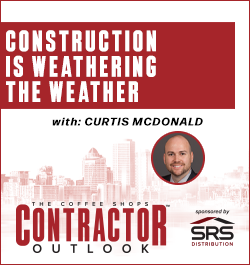OVERHEAD
« Back To Roofers TalkOkay it's me again...I was wondering what some of you figure your overhead costs at. When I was working out of our home overhead was never an issue, and if there was money in the bank I thought I must be doing something right. In June 2006 I took a huge leap of faith, and brought a building, warehouse etc. now I'm flopping around like a fish ouf of water. I have to run this business like a corporation (which it is) but trying to keep track of expenses, figure overhead, cost per man hour,forecasting, projections, bla bla bla is driving me NUTS!!!! If my figures are right I think my overhead is running about 31% can that be right? What is your overhead running and where should I be?>>>
Call Ren Carlton at Dynamic Advisory Solutions (248-619-9988). He might be able to help you out.>>>
wywoody
Im from Central Illinois.>>>
DAMMMMMMM, I am just feeling so overwhelmed, I would have to agree with the number 7 theory. I do not like running my business like this. I need to make some hard decision in the very near future. I seem like I am jumping from one fire to the next. In June I hired a "Company" that was suppose to help me turn my company around and signed a contract for one-year. Now a month 1/2 later I'm out $2,500.00 and all I've gotten from DAS was fire everybody and stop paying your credit cards. Needless to say I fired there butts first thing this morning. :angry:>>>
Terry you have 16.5 full time employees on 1-1.5 mil in sales. What is the annual payroll? Being on the cheap end it still would have to be over 600K plus benefits, or am I even close?
What were your employee numbers when you worked from home and before you bought the building?
This situation sort of reminds me of a conversation I had with a fellow when I first got into business. He had been running roofing companies all his life up and down the West Coast following different building boom areas.
He warned me about the number "7". He told me that in order to survive in the business you should never have more than 7 employees unless you are prepared to grow your company to over 40 employees. He found that trying to run an operation with anything in between was usually a death blow to the company.
He told me that it is too hard for 1 person to manage more than 7 employees. After you cross the "7" line you will have to either hire someone for the office or someone for sales because you can no longer do it all. As soon as you have paid staff that are not producing income for the company (ie: office staff) how many more production crew do you have to hire to produce enough profit to pay the office staff? How big of a production crew can you have on payroll before you will require a field supervisor to co-ordinate them? Who many more production crew do you need to pay the supervisors wages? Do you then have to hire a yardman to keep materials moving? How many more production crew do you need to pay his wages? By this time you probably need more office help, which starts the cycle over again.
This fellow told me that in his experience he found that it took a 40 person company to produce the same personal income and profit to him as he was making with just 7 employees on staff. Over the years I have looked around and have seen the survivors in this industry were either small operations under the "7" number or large operations over the "40" number. Most companies that die cross the "7" line without a concrete plan for sustained growth to bring them over the "40" number.
Just my rambling thoughts. :blink:>>>
Welcome TyJax, what town are you in?>>>
Hi Guys,
I have been lurking for quite some time. I feel like I know several of you already.
Our over head is about 31-33% we actually build in 38% for growth. It has worked nicely so far.
For anyone who is a partner-owner-president ETC. you, yourself should be able to waive off you work comp rights and go with a HUGLY less expensive policy. Say a Disability policy. Here is the real nice part. My Disability policy has more to offer if I should ever use it, way more than work comp will ever. Talk to your insurance agent about this to make sure it is legal in your area.
Vaa Fakaosifolau I love you jobs. You do these jobs, documented so well with pic's. All the details look flawless. Good work man. I too like a lot of photo's. I have saved my butt before with pic's. Homeowners trying to put the blame on us for some crap, but in the pre job photo there it was a broken up already.
Thanks>>>
Miscreant has me so paranoid on another thread that I feel it necessary to make a small clarification in order to fully declare the complexification complete.
Your "ratio" of overhead to labor is properly stated 1.5:1 :lol:>>>
:blink: Holy Cow, this is the complete complexification of contracting. Twill, give me a call tomorrow.
.>>>
Twill, turning it into a ratio your overhead is 150% of your labor cost.
60 divided by 40 = 1.5
That's very typical of what I see.>>>
I'll chime in here. twill I know you didn't ask me . Here is how I handled it back in the day. For a quick analysis I would take the labor material and all other direct cost associated to the project ( This was on every job not just one through out the year )Divide that number by 60% That would put me in the ball park. Then I would divide the material cost by 80% to give me my 20% mark up. That always worked for me. I was always accused of being a bean counter.>>>
Twill,
Is there a question in there?>>>
Thanks EGG it's good to hear from some of the old timers.>>>
I must have missed the wrestling story, but I remember the 3 'r's and have enjoyed terry's posts for a long time. I have to say it is kind of gratifying to see Mike's overhead advice land with such a satisfying impact after all these years. He is a patient man and has given various forms of this advice many times, but with one thing and another, and no telling who is or isn't searching for information or who is or isn't even scanning one of the threads it gets posted into, most of the time it seemed to me that the information simply glanced off.
We tradesmen turned contractors (the insurance industry attempts to categorize us as 'artisan contractors') who persist in wearing tools have an intimate comprehension of just how time-based everything is. The classic joke of course is that when we bid something too low, we tell everybody that we are working for free. We run calculations to see how late in the year (a normal year) it was before we started counting the money we made as our own. Let's see now...will it be August, September, or October? No wonder we aren't cheap. But if we took off our tool belts and became part of the overhead, would we even make it before Christmas? Not if we can't expect our mechanics to do MUCH more than carry their own wage.
What I liked most about Mike's method was the way all the different types of jobs and all the different types of overhead expense got blended together to yield a weighted average. That takes out the distortion from jobs that are mostly labor, jobs that are mostly material, and all the variations in between, which will drive you nuts if you try to extrapolate from any single one of them.
The notion that certain types of jobs were profitable and certain types of jobs were not EVEN WHEN the workmen were doing their best in every case, was illuminating. My answer to this problem, as a small, working, owner, is to charge more (than I have to make just to get by), work harder than I have to work (because I love to work), keep my overhead as low as humanly possible (as in no advertising), make sure my customers are nearly always MORE than merely satisfied, and produce a superior product at a medium price.
I have NO illusions that this is translatable or commutable to a situation where most of the customers do not get one-on-one communion with a working owner. The whole situation has to get modified and stabilized. Mike's method does that.>>>
Terry,
I could never forget a woman that coached wrestling. :) (BTW, it was Terrry, 3 "r"s)
Twill, I include burden in my overhead. But when I said 200%, that ABOVE AND BEYOND the labor.
So if I had 2,000 in labor, my overhead would be close to 4,000, for a total of 6,000.>>>
THANK YOU....THANK YOU....THANK YOU... That's exactly what I'm going to do hummmmm why didn't I think of that. Hey Mike do you remember me I think I use to be logged on as Terrrry or Terryy? Thanks again for the great advice!@ :kiss:>>>









-2.png)









